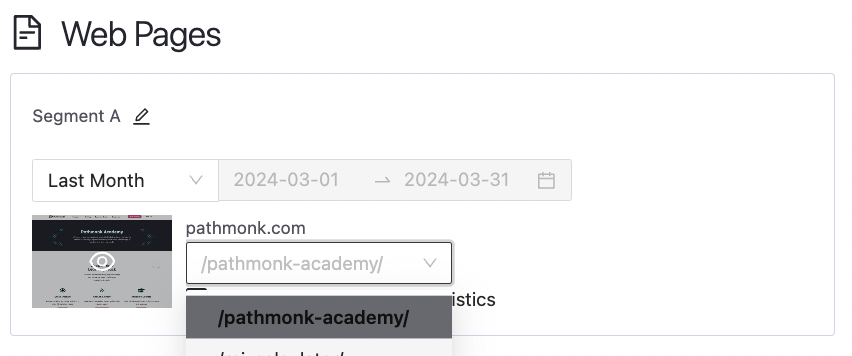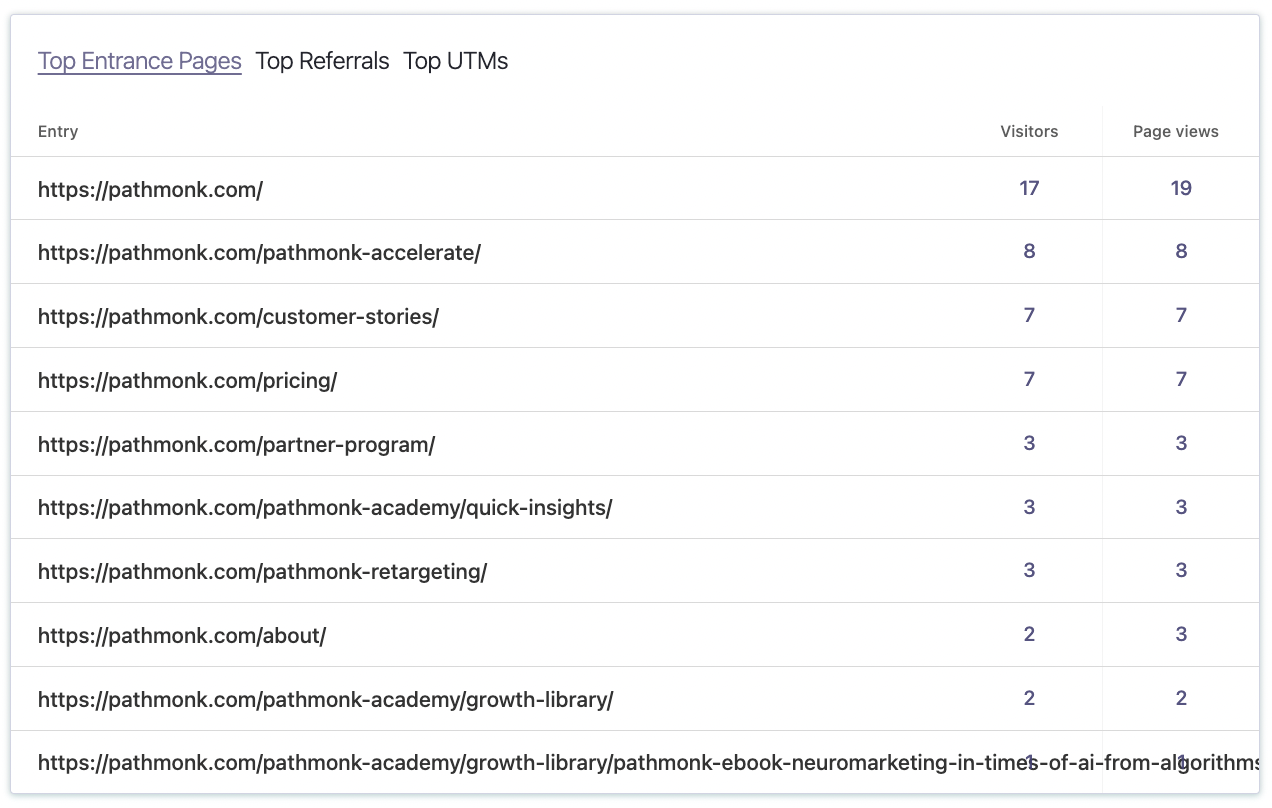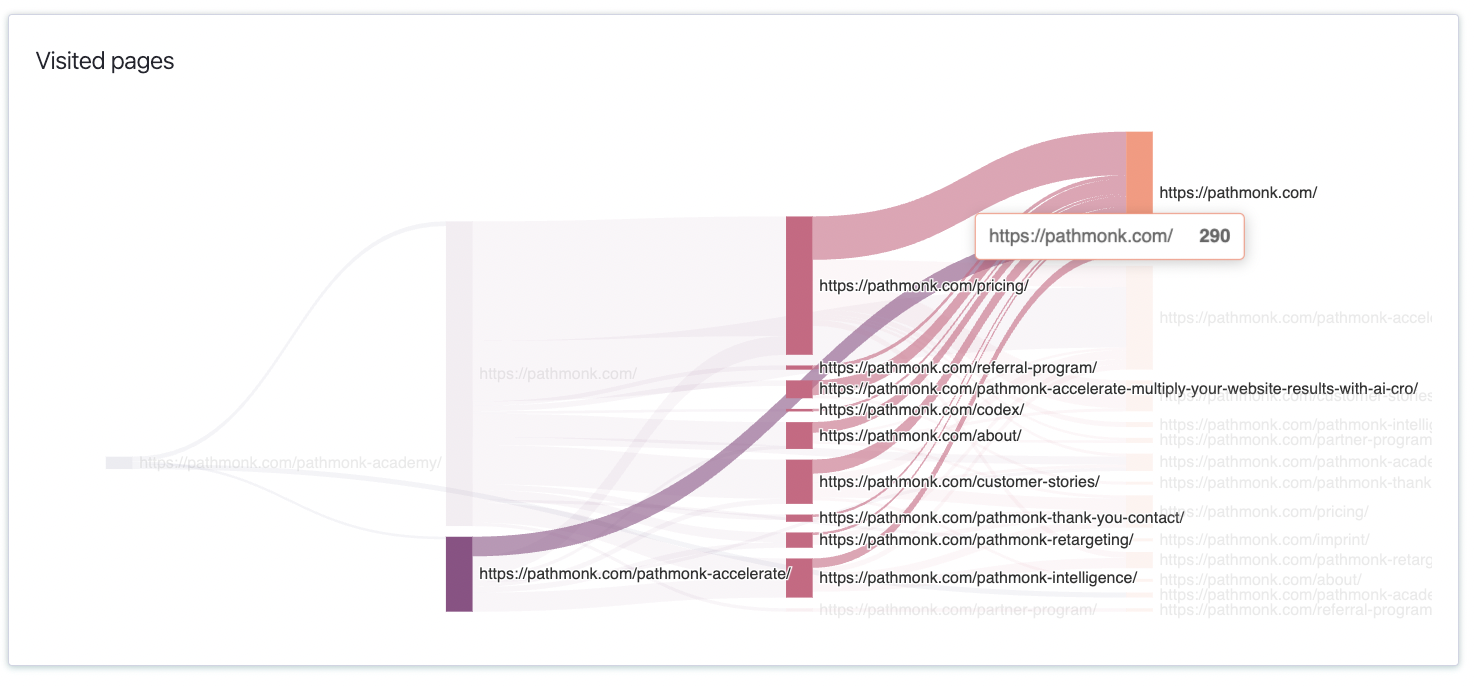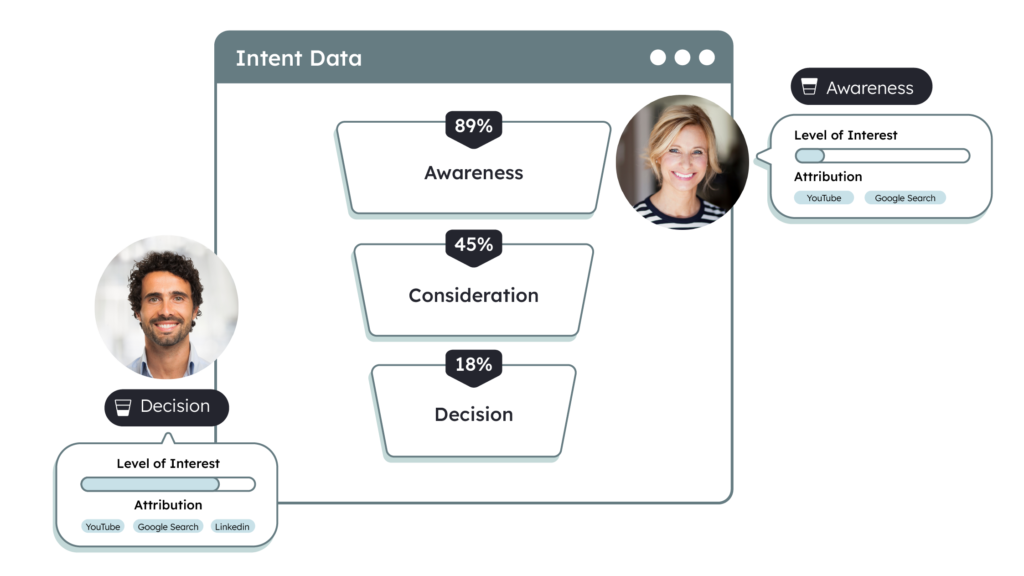Marketers and website owners are constantly grappling with the challenge of decoding the digital footprints left by their visitors. Where did they go? What did they see right before converting? What made them leave??
The ultimate goal, evidently, is to increase website conversions and reduce the dreaded abandonment rates that plague many online experiences. However, truly comprehending the multitude of interactions and behaviors a user exhibits on a company’s website requires more than just surface-level analysis.
It demands a deep dive into the data, which, let’s face it, sounds a bit daunting.
Until now. Pathmonk Intelligence offers marketers a comprehensive view of their visitors’ behavior flow, unlocking insights that go beyond traditional metrics. This powerful understanding allows for the optimization of every touchpoint on the user journey, ensuring that potential customers remain engaged, satisfied, and more likely to convert.
Let’s see how it goes.
Table of Contents
Step by Step: Analyzing your Users’ Behavior Flow with Pathmonk Intelligence
1. Identify Your Goal
Begin by identifying the key objective you wish to achieve with your website. This could be increasing product sales, generating leads, or enhancing user engagement with content.
Based on your objective, access the Web Pages report on the left menu of Intelligence. Select a page on your website that is critical to achieving this goal. This could be a landing page, a product page, a contact form, or any other page that is vital to your conversion funnel.

Set the dates for analysis, and if necessary, compare the focus page against another page or a different time period for comprehensive insights.
2. Understand the Top Entry Pages
In the Web Pages report, scroll down to the Top Entrance Pages section, with the entry pages leading to your focus page. These are the pages where users begin their journey before arriving at the focus page.

Assess the content and layout of these entry pages. Are they effectively guiding users to the focus page? Understanding this can help you identify opportunities to streamline the path to conversion.
Based on your findings, consider optimizing these entry pages. This might involve clearer navigation cues, more compelling CTAs, or ensuring the content aligns with user intent.
3. Map Your Behavior Flow
While staying in the Web Pages report, go to the Visited Pages section to visualize the path users take through your site after visiting that page. Are they proceeding along your desired conversion path, are they dropping off, or visiting pages that you were not expecting?

For instance, you can analyze what are the most frequently visited pages of your website after landing on your homepage, or what your visitors do after seeing one of your product pages.
Look for patterns or common exit points. These are critical areas where your website may be losing potential conversions.
Based on your analysis, implement changes to address these drop-off points. This might involve page optimizations, adding additional information or reassurance, or simplifying the next steps in the conversion process.
Understand your customer journey analytics
See how your users behave, find drop-offs, and receive actionable insights with AI.

Understanding the Importance of Visitor Behavior Analysis
Understanding user behavior is crucial for several compelling reasons, especially in the context of digital products and services. It provides the foundation upon which successful user experiences are built, influencing everything from website design to product development.
Here’s why understanding user behavior is so important:
1. Enhancing User Experience (UX)
Understanding user behavior allows designers and developers to create more intuitive and enjoyable user experiences. By knowing what users want, expect, and how they tend to interact with digital interfaces, companies can design products that are easier to use, meet user needs more effectively, and are more engaging.
2. Increasing Conversion Rates
A deep understanding of user behavior can lead to significant improvements in conversion rates. By analyzing how users navigate a site, where they spend the most time, and what actions they take before converting, businesses can optimize their websites and marketing strategies to encourage more of these desired actions.
3. Identifying and Solving Problems
User behavior analysis can highlight issues or barriers that users encounter on a website or within an app. These might be technical problems, confusing navigation, or content that doesn’t meet their needs. Identifying these issues allows for targeted improvements, enhancing the overall quality of the digital product.
4. Personalizing User Interactions
Personalization is key to engaging and retaining users. Understanding individual and group behaviors enables companies to tailor experiences, recommendations, and content to match user preferences and past interactions, leading to a more personalized and relevant experience for each user.
If you want to take your personalization efforts to the next level with our AI, try our interactive demo and see how we could help you convert more website visitors.
5. Improving Customer Retention
A positive user experience, driven by an understanding of user behavior, is critical for customer retention. Users are more likely to remain engaged with a product or brand that continually meets their needs and expectations, offers a seamless experience, and values their feedback.
6. Optimizing Marketing Strategies
Marketing efforts can be greatly enhanced by understanding user behavior. This knowledge allows for more targeted, effective campaigns that speak directly to the user’s preferences and behaviors. It also helps in identifying the most suitable channels and messages for reaching specific user segments.
Pathmonk Intelligence: The solution for User Flow Analysis
Pathmonk Intelligence stands out as a uniquely positioned tool in the analytics space, offering a blend of privacy compliance, user-centric insights, and ease of use that sets it apart from conventional analytics solutions.

This is why Pathmonk Intelligence will become your trusted friend when doing your user behavior analysis:
- Privacy-Friendly Analytics: Thanks to its cookieless technology, Pathmonk Intelligence prioritizes user privacy without compromising on the depth and quality of analytics. It collects and processes data in a way that is fully compliant with GDPR and other privacy laws, ensuring that businesses can analyze user behavior without infringing on user rights.
- Simple, Intuitive Dashboard: Unlike other analytics platforms that may overwhelm users with complex interfaces and an overload of data, Pathmonk Intelligence features a simple, intuitive dashboard. This design choice ensures that marketers can easily navigate through insights and find the information they need without any hassle.
- Effortless Setup: One of the significant barriers to implementing an analytics solution is the complexity of setup. Pathmonk Intelligence addresses this challenge by offering an easy, straightforward setup process. Businesses can start tracking and analyzing user behavior with minimal effort and technical know-how, making it accessible to marketers of all skill levels.
- Actionable Insights: Beyond merely presenting data, Pathmonk Intelligence excels at delivering actionable insights. Marketers receive clear, concise recommendations on how to improve user flow, enhance user experience, and increase conversion rates. These insights are directly linked to specific aspects of the user journey, making it easier for marketers to implement targeted optimizations.
How to Add Pathmonk Intelligence to Your Marketing Strategy
Step 1: Set Up your Pathmonk Intelligence Account
If you want a hands-on test of how Pathmonk Intelligence works and what it can do for you, sign up for a free Demo. This hands-on experience will provide you with valuable insights into how Pathmonk Intelligence can work to your advantage.
Alternatively, you can directly start your journey with Pathmonk Intelligence by signing up for an account.
Step 2: Onboarding and Installation
Once registered, the next step is to integrate Pathmonk Intelligence with your platform.
The onboarding process has been designed to be exceptionally user-friendly, making it a self-service experience that ensures you’re up and running smoothly.
Step 3: Data Configuration
Your business is one-of-a-kind, and so are your objectives. We encourage you to customize your data collection settings to precisely align with your unique business goals. This level of customization empowers you to tailor your goals, ensuring that you receive the most relevant insights that will truly impact your success.
You have the flexibility to establish your goals using various methods: through a URL, a pixel that doesn’t rely on cookies, or by integrating with a third-party application. No matter which option you choose, you won’t need developers. However, if you encounter any issues with your data configuration, you can always contact our support team.
Applying User Flow Insights to your Marketing Strategy
Once you have gathered and analyzed your user behavior flow data, you’re in a prime position to use these insights to enhance your marketing efforts significantly. Here’s how you can leverage this data:
Optimize Conversion Funnels
Identify where in the user flow the drop-offs occur most frequently and address these points to smooth the path to conversion.
How? Simplify the checkout process, enhance CTAs, and ensure that each step in the user journey is intuitive and leads seamlessly to the next. A/B test different approaches to find the most effective solutions.
Enhance Your Advertising Strategy
Identify the most effective pathways that lead to conversion and use this information to inform your advertising strategy.
How? Allocate more budget to the channels and campaigns that drive users through the most efficient conversion paths. Use behavior flow data to refine ad targeting, copy, and creative to better align with user preferences and behaviors.
Tailor Your Content Strategy
Use the insights to understand which types of content engage users the most and lead them towards conversion. This can help tailor your content creation efforts more effectively.
How? Create more content that mirrors the high-performing types, whether it’s blog posts, videos, or infographics. Optimize existing content to better align with what has been proven to engage your audience.
Improve Cross-channel Cohesion
Ensure that the user experience is consistent across all channels, from social media to your website, based on the behavior flow insights.
How? Align messaging, design, and calls to action across all platforms to create a cohesive multi-channel experience that guides users towards your conversion goals, no matter where they begin their journey.





